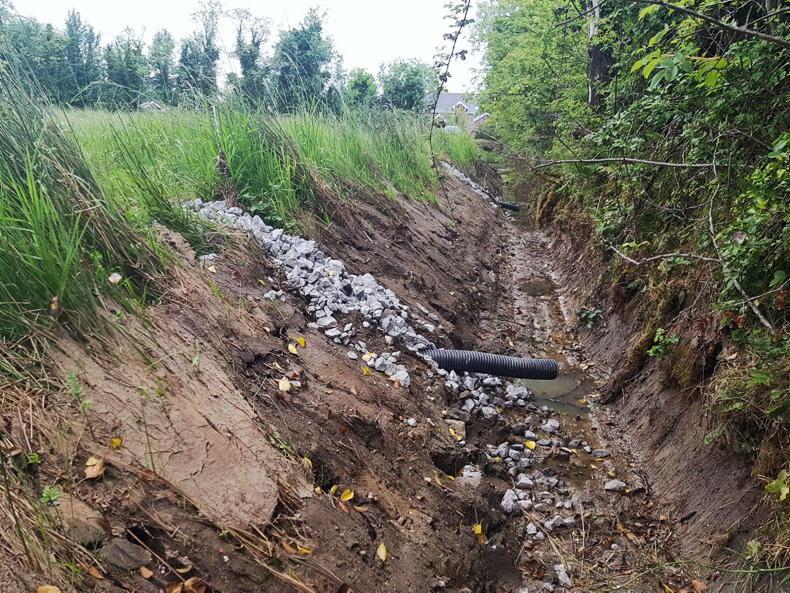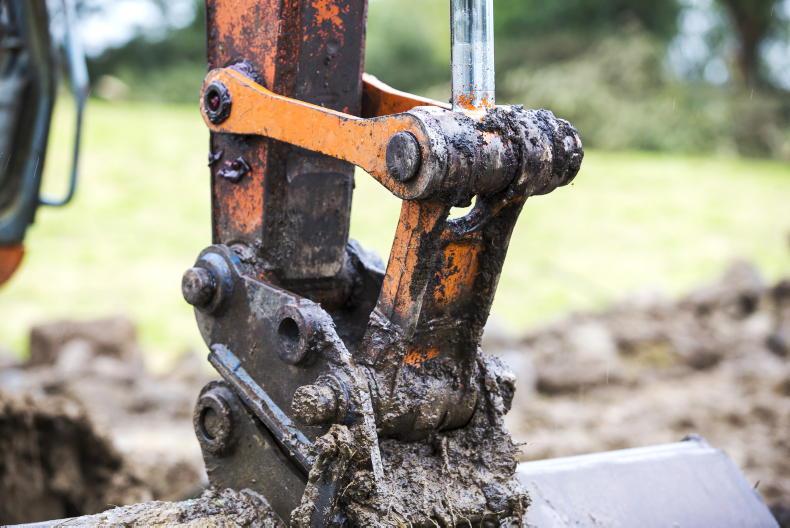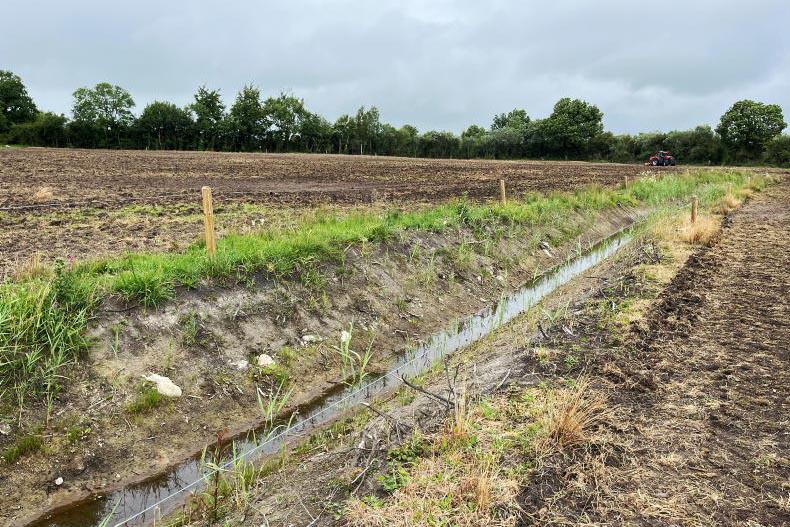The objective of any form of land drainage is to remove excess water from the soil, to lower the water table, and to reduce the period of waterlogging. This can have potential benefits such as lengthening the grass growing and grazing season, improving utilisation of grazed grass by livestock and improving accessibility of machinery to land.
Drainage of poorly drained mineral soils has positive effects on greenhouse gas emissions by reducing losses of nitrous oxide, while drainage is linked to significant carbon loss on carbon-rich soils, such as peats. Drainage works should, therefore, be focused on mineral soils. A number of drainage techniques have been developed to suit mineral soil types. There are two main categories of land drainage systems, groundwater and shallow:
Groundwater drainage systems are recommended where there is strong inflow of water or seepage from the faces of soil test pit walls indicating layers of high permeability. The installation of field drains at the depth of inflow will facilitate the removal of groundwater assuming a suitable outfall is available. Deep field drains are usually installed at a depth of 1.5m to 2.5m and at spacings of 15m to 50m. Field drains should always be installed across the slope to intercept as much groundwater as possible. A shallow drainage system is required where a test pit shows no inflow of water at any depth. 
These soils with no obvious permeable layer and very low hydraulic conductivity are more difficult to drain. Shallow drainage systems are those that aim to improve the capacity of the soil to transmit water by fracturing and cracking it. These include mole drainage and gravel mole drainage.
Mole drainage is suited to soils with high clay content that form stable channels. Gravel filled mole drains are required in unstable soils where an ordinary mole will not remain open. Gravel moles require a gravel aggregate within the 10mm to 20mm size range to function properly.
Performance analysis of drainage systems installed on heavy soils programme (HSP) farms allows examination of the impact of the type of drainage system, soil type and seasonal variations in soil moisture on drainage system performance.
Deeper drainage systems, with direct connectivity to groundwater, discharge greater volumes of water and maintain a deeper water table compared with shallow drainage designs. Drainage works on mineral soils increased grass production by between 4t DM/ha and 7t DM/ha per year.
This is Dairying’ photo competition
The ‘This is Dairying’ competition, in conjunction with the Teagasc Moorepark Open Day, has run throughout June 2023. The idea behind the competition is to give people the opportunity to show what they love about dairy farming with the chance to win some exciting prizes.
The competition aims to exhibit pride and positivity across the dairy industry, whether that is featuring the importance of the family farm, pride in your animals or your dedication to safeguarding the environment.
It provides an excellent opportunity for budding photographers and photo enthusiasts to get snapping. The ‘This is Dairying’ competition winners will be selected and photos will be displayed online and at the Teagasc Moorepark open day.
The objective of any form of land drainage is to remove excess water from the soil, to lower the water table, and to reduce the period of waterlogging. This can have potential benefits such as lengthening the grass growing and grazing season, improving utilisation of grazed grass by livestock and improving accessibility of machinery to land.
Drainage of poorly drained mineral soils has positive effects on greenhouse gas emissions by reducing losses of nitrous oxide, while drainage is linked to significant carbon loss on carbon-rich soils, such as peats. Drainage works should, therefore, be focused on mineral soils. A number of drainage techniques have been developed to suit mineral soil types. There are two main categories of land drainage systems, groundwater and shallow:
Groundwater drainage systems are recommended where there is strong inflow of water or seepage from the faces of soil test pit walls indicating layers of high permeability. The installation of field drains at the depth of inflow will facilitate the removal of groundwater assuming a suitable outfall is available. Deep field drains are usually installed at a depth of 1.5m to 2.5m and at spacings of 15m to 50m. Field drains should always be installed across the slope to intercept as much groundwater as possible. A shallow drainage system is required where a test pit shows no inflow of water at any depth. 
These soils with no obvious permeable layer and very low hydraulic conductivity are more difficult to drain. Shallow drainage systems are those that aim to improve the capacity of the soil to transmit water by fracturing and cracking it. These include mole drainage and gravel mole drainage.
Mole drainage is suited to soils with high clay content that form stable channels. Gravel filled mole drains are required in unstable soils where an ordinary mole will not remain open. Gravel moles require a gravel aggregate within the 10mm to 20mm size range to function properly.
Performance analysis of drainage systems installed on heavy soils programme (HSP) farms allows examination of the impact of the type of drainage system, soil type and seasonal variations in soil moisture on drainage system performance.
Deeper drainage systems, with direct connectivity to groundwater, discharge greater volumes of water and maintain a deeper water table compared with shallow drainage designs. Drainage works on mineral soils increased grass production by between 4t DM/ha and 7t DM/ha per year.
This is Dairying’ photo competition
The ‘This is Dairying’ competition, in conjunction with the Teagasc Moorepark Open Day, has run throughout June 2023. The idea behind the competition is to give people the opportunity to show what they love about dairy farming with the chance to win some exciting prizes.
The competition aims to exhibit pride and positivity across the dairy industry, whether that is featuring the importance of the family farm, pride in your animals or your dedication to safeguarding the environment.
It provides an excellent opportunity for budding photographers and photo enthusiasts to get snapping. The ‘This is Dairying’ competition winners will be selected and photos will be displayed online and at the Teagasc Moorepark open day.












SHARING OPTIONS